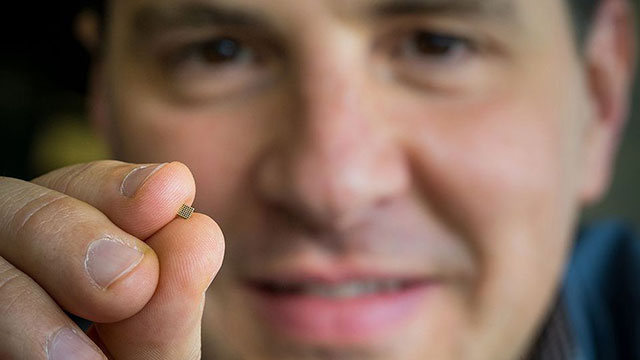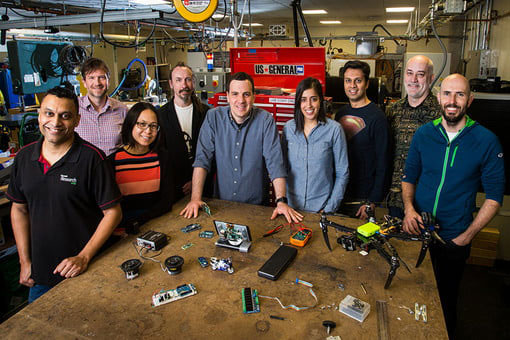Microsoft plans to bring AI into Raspberry Pi
That's why the AI system relies on local sensors to collect input data while more powerful hardware on the cloud manages the heavy part of the output data. That's how Siri and Amazon Alexa work, how IBM Watson solves almost any job. However, it is still a limited approach to creating smarter IoT and intelligence applications without an Internet connection.
'The main model is that these devices (sensors) are useless,' said senior researcher at Microsoft Research India, Manil Varma.
Currently, Varma's team in India and Microsoft researchers in Redmond, Washington (the whole project led by researcher Ofer Dekel) has discovered how to compress the neural network, the synapses of Machine. Learning from 32-bit down, sometimes, there's only a bit left and running them on a $ 10 Raspberry Pi, a small computer the size of a card, costs less power with more ports and no screens. It is really an open source motherboard that can be exploited anywhere. The company announced this research in a blog post.

Researcher Ofer Dekel with a micro-processor can run the Machine Learning algorithm someday
Microsoft's work is part of a big trend, bringing Machine Learning closer to devices and end users.
Earlier this month at the WWDC conference, Apple announced the new API Machine Learning (Vision & Natural Language) to allow developers to add Machine Learning-based intelligence to the application with just a few lines of code. They also revealed Core ML for developers with deeper knowledge of AI to take advantage of the ability to intervene in hardware. Apple's model helps developers teach Machine Learning algorithms on the Apple library provided. The system then switches the code to run the AI on the device.
Obviously in Apple's case, the hardware in the iPhone is worth $ 700 and the CPU is much more powerful than anything that can be found on Raspberry Pi. But this trend is also very clear. These companies are bringing AI closer to users' devices, where it may rely less on accessing huge data in the cloud.
'If you're driving on the road and can't connect to the network, you won't want the AI to stop working. In fact, that's when you need it most, 'Varma said.
With this approach, we can understand the simpler and sensor-based tasks that can be learned by location, intention, recent actions or device data. In the near future, it may be the solution to a cancer treatment, for example (one of Watson Al's areas of interest at IBM).
With Microsoft, this Raspberry Pi breakthrough is simply the first stage in the neural network compression workflow so they can run on a hierarchical micro controller. To achieve that, according to Microsoft, the Machine Learning model needs to be 10,000 times smaller. That is the problem they are still dealing with.

Microsoft researchers are considering bringing AI to Raspberry Pi
At the same time, Microsoft also released the Preview version of the Machine Learning algorithm to the size of the Raspberry Pi on GitHub, where developers can try it out, tap on Raspberry Pi 3 and Raspberry Pi Zero.
Finally, this is part of Microsoft's Intelligent Edge strategy that CEO Satya Nadella outlined at the beginning of the year at the Microsoft Build conference. Microsoft hopes to see micro-processors that use AI to be used in offices to the clothes we wear.
With Varma, who also has decreased vision, this study is somewhat more personal. His team is developing a prototype of a smart walking stick to illustrate their research.
You should read it
- Raspberry Pi Zero vs Model A and B, how are they different?
- How to start Raspberry Pi 3 from USB
- Why should people try Raspberry Pi 4?
- Raspberry Pi 3 Model A +: 8-core chip, clocked at 1.4GHz, priced at $ 25
- Learn Pi Imager, How to Use Raspberry Pi Imager
- How to use Raspberry Pi Imager to install Raspberry Pi OS
- 5 ways to make good use of Raspberry Pi 4
- 7 best Raspberry Pi 4 cases
May be interested
- 7 best Raspberry Pi 4 cases
 although the raspberry pi 4 is quite small, that doesn't mean you shouldn't equip it with an appropriate 'home'. here are the 7 best raspberry pi 4 cases you can buy right now.
although the raspberry pi 4 is quite small, that doesn't mean you shouldn't equip it with an appropriate 'home'. here are the 7 best raspberry pi 4 cases you can buy right now. - How to set up Raspberry Pi
 you may need some extra hardware and software for many of these projects, but the raspberry pi is still a great base.
you may need some extra hardware and software for many of these projects, but the raspberry pi is still a great base. - What is the difference between Raspberry Pi 4 and other models?
 raspberry pi 4 is a game changer. here's what you need to know about pi 4 and how this model is different from the previous raspberry pi 3b +.
raspberry pi 4 is a game changer. here's what you need to know about pi 4 and how this model is different from the previous raspberry pi 3b +. - What's New in Raspberry Pi OS 11?
 about every two years, debian releases a new stable version of its operating system. since the raspberry pi os is based on debian, the developers release a new version every time debian receives an lts release. the latest update is full of useful changes.
about every two years, debian releases a new stable version of its operating system. since the raspberry pi os is based on debian, the developers release a new version every time debian receives an lts release. the latest update is full of useful changes. - How to add buttons on the Raspberry Pi machine
 learning to use gpio batteries on raspberry pi will open your eyes to a potential world. the basic principles gained through beginner projects will be useful for both tinkering with diy electronics and programming.
learning to use gpio batteries on raspberry pi will open your eyes to a potential world. the basic principles gained through beginner projects will be useful for both tinkering with diy electronics and programming. - How to set up Wi-Fi and Bluetooth on Raspberry Pi 3
 while the raspberry pi model b + and the raspberry pi 2 have added usb ports, the best solution is still to have bluetooth and wi-fi integrated, which users finally get in the raspberry pi 3.
while the raspberry pi model b + and the raspberry pi 2 have added usb ports, the best solution is still to have bluetooth and wi-fi integrated, which users finally get in the raspberry pi 3. - How to connect directly to a Raspberry Pi without Internet
 the versatility of raspberry pi means that at some point you may have to use it outside or out of range of wireless networks. so how can you use it without plugging in the keyboard and screen?
the versatility of raspberry pi means that at some point you may have to use it outside or out of range of wireless networks. so how can you use it without plugging in the keyboard and screen? - How to use the Xbox or PS4 game console with Raspberry Pi
 today's article will show you how to make retropie work, before attaching a gaming handle to the raspberry pi.
today's article will show you how to make retropie work, before attaching a gaming handle to the raspberry pi. - Everything you need to know about overclocking your Raspberry Pi 5
 although the raspberry pi 5 is 2 to 3 times faster than the pi 4, it can be overclocked for even better performance.
although the raspberry pi 5 is 2 to 3 times faster than the pi 4, it can be overclocked for even better performance. - Raspberry Pi 4 officially launched, quad-core Cortex-A72 1.5 GHz, maximum RAM of 4GB
 after the last days of waiting, the raspberry pi 4 computer has officially been released with many improvements and significant improvements compared to the raspberry pi 3.
after the last days of waiting, the raspberry pi 4 computer has officially been released with many improvements and significant improvements compared to the raspberry pi 3.










 Google invests in news sites with robots as robots
Google invests in news sites with robots as robots AI is not as scary as you think, this is the reason
AI is not as scary as you think, this is the reason Panic because chatbot talks to each other in their own language? This is the truth
Panic because chatbot talks to each other in their own language? This is the truth Intel revealed new AI chips to compete with Nvidia's GPUs
Intel revealed new AI chips to compete with Nvidia's GPUs Sophia - What is the world's first civilian robot in Saudi Arabia?
Sophia - What is the world's first civilian robot in Saudi Arabia? Nvidia's AI Bot creates the face of a real person
Nvidia's AI Bot creates the face of a real person